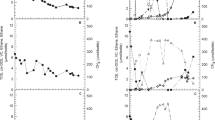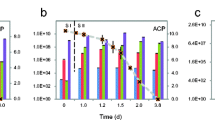Abstract
In polluted soil or ground water, inorganic nutrients such as nitrogen may be limiting, so that Monod kinetics for carbon limitation may not describe microbial growth and contaminant biodegradation rates. To test this hypothesis we measured14CO2 evolved by a pure culture ofAcinetobacter johnsonii degrading 120 µg14C-phenol per ml in saturated sand with molar carbon:nitrogen (CN) ratios ranging from 1.5 to 560. We fit kinetics models to the data using non-linear least squares regression. Phenol disappearance and population growth were also measured at CN1.5 and CN560.
After a 5- to 10-hour lag period, most of the14CO2 evolution curves at all CN ratios displayed a sigmoidal shape, suggesting that the microbial populations grew. As CN ratio increased, the initial rate of14CO2 evolution decreased. Cell growth and phenol consumption occurred at both CN1.5 and CN560, and showed the same trends as the14CO2 data. A kinetics model assuming population growth limited by a single substrate best fit the14CO2 evolution data for CN1.5. At intermediate to high CN ratios, the data were best fit by a model originally formulated to describe no-growth metabolism of one substrate coupled with microbial growth on a second substrate. We suggest that this dual-substrate model describes linear growth on phenol while nitrogen is available and first-order metabolism of phenol without growth after nitrogen is depleted.
Similar content being viewed by others
References
Allison FE & Cover RG (1960) Rates of decomposition of shortleaf pine sawdust in soil at various levels of nitrogen and lime. Soil Sci. 89: 194–201
American Public Health Association (1989) Standard methods for the examination of water and wastewater. 17th ed. 5530 D. Direct photometric method (p 5–54)
Babich H & Davis DL (1981) Phenol: A review of environmental and health risks. Regulat. Toxicol. Pharmacol. 1: 90–109
Borden RC & Bedient PB (1986) Transport of dissolved hydrocarbons influenced by oxygen-limited biodegradation. 1. Theoretical development. Water Resour. Res. 22: 1973–1982
Brunner W & Focht DD (1984) Deterministic three-half-order kinetic model for microbial degradation of added carbon substrates in soil. Appl. Environ. Microbiol. 47: 167–172
Dibble JT & Bartha R (1979) Effect of environmental parameters on the biodegradation of oil sludge. Appl. Environ. Microbiol. 37: 729–739
Eckel WP, Trees DP & Kovell SP (1985) Distribution and concentration of chemicals and toxic materials found at hazardous waste dump sites, pp 250–257. Proceedings: Natl. Conf. Hazardous Wastes and Environmental Emergencies, Cincinnati, OH. 14-16 May 1985. Hazardous Materials Control Research Inst. Silver Spring, MD (pp 250–257)
Focht DD & Brunner W (1985) Kinetics of biphenyl and polychlorinated biphenyl metabolism in soil. Appl. Environ. Microbiol. 50: 1058–1063
Ghiorse WC & Wilson JT (1988) Microbial ecology of the terrestrial subsurface. Adv. Appl. Microbiol. 33: 107–172
Hess TF, Schmidt SK, Silverstein J & Howe B (1990) Supplemental substrate enhancement of 2,4-dinitrophenol mineralization by a bacterial consortium. Appl. Environ. Microbiol. 56: 1551–1558
Hoben HJ & Somasegaran P (1982) Comparison of the pour, spread, and drop plate methods for enumeration ofRhizobium spp, in inoculants made from presterilized peat. Appl. Environ. Microbiol. 44: 1246–1247
Juni E (1984) Genus III.Acinetobacter Brisou and Prevot 1954, 727AL. In: Krieg NR (Ed) Bergey's Manual of Systematic Bacteriology, Vol 1. (pp 303–307) Williams & Wilkins, Baltimore
Keeney D (1986) Sources of nitrate to ground water. CRC Crit. Rev. Environ. Control 16: 257–304
Lederer WH (1985) Regulatory chemicals of health and environmental concern. Van Nostrand Reinhold Company Inc. (pp 224–225)
Lee MD, Thomas JM, Borden RC, Bedient PB, Wilson JT & Ward CH (1988) Biorestoration of aquifers contaminated with organic compounds. CRC Crit. Rev. Environ. Control. 18: 29–89
Lerch RN, Barbarick KA, Sommers LE & Westfall DG (1992) Sewage sludge proteins as labile carbon and nitrogen sources. Soil Sci. Soc. Am. J. 56: 1470–1476
Mankad T & Bungay HR (1988) Model for microbial growth with more than one limiting nutrient. J. Biotechnol. 7: 161–166
Mankad T & Nauman EB (1992) Modeling of microbial growth under dual limitations. Chem. Eng. J. 48: B9-B11
Martin RW (1949) Rapid colorimetric estimation of phenol. Anal. Chem. 21: 1419–1420
Megee RD, Drake JF, Fredrickson AG & Tsuchiya HM (1972) Studies in intermicrobial symbiosis.Saccharomyces cerevisiae andLactobacillus casei. Can. J. Microbiol. 18: 1733–1742
Molz FJ, Widdowson MA & Benefield LD (1986) Simulation of microbial growth dynamics coupled to nutrient and oxygen transport in porous media. Water Resour. Res. 22: 1207–1216
Paris DF & Rogers JE (1986) Kinetic concepts for measuring microbial rate constants: Effects of nutrients on rate constants. Appl. Environ. Microbiol. 51: 221–225
Parkin TB, Shelton DR & Robinson JA (1991) Evaluation of methods for characterizing carbofuran hydrolysis in soil. J. Environ. Qual. 20: 763–769
Rifai HS & Bedient PB (1990) Comparison of biodegradation kinetics with an instantaneous reaction model for groundwater. Water Resour. Res. 26: 637–645
Robinson JA & Tiedje JM (1983) Nonlinear estimation of Monod growth kinetic parameters from a single substrate depletion curve. Appl. Environ. Microbiol. 45: 1453–1458
Rößner U, Hoyle BL & Scow KM (in press) Effect of carbon : nitrogen ratios on growth kinetics ofAcinetobacter johnsonii metabolizing phenol in liquid and saturated sand. Proceedings Second International Conference on Ground Water Ecology. U.S. Environmental Protection Agency & American Water Resources Association. 27–30 March 1994, Atlanta GA
Schmidt SK & Gier MJ (1989) Dynamics of microbial populations in soil: Indigenous microorganisms degrading 2,4-dinitrophenol. Microb. Ecol. 18: 285–296
Schmidt SK, Simkins S & Alexander M (1985) Models for the kinetics of biodegradation of organic compounds not supporting growth. Appl. Environ. Microbiol. 50: 323–331
Simkins S & Alexander M (1984) Models for mineralization kinetics with the variables of substrate concentration and population density. Appl. Environ. Microbiol. 47: 1299–1306
Sims JL, Suflita JM & Russell HH (1992)In-situ bioremediation of contaminated ground water. U.S. EPA, Robert S. Kerr Environmental Research Laboratory, Ada, OK. Ground Water Issue Paper. EPA/540/S2/003
Sinclair JL, Randtke SJ, Denne JE, Hathaway LR & Ghiorse WC (1990) Survey of microbial populations in buried-valley aquifer sediments from northeastern Kansas. Ground Water. 28: 369–377
Stetzenbach LD, Kelley LM & Sinclair NA (1986) Isolation, identification, and growth of well-water bacteria. Ground Water. 24: 6–10
Swindoll CM, Aelion CM & Pfaender FK (1988) Influence of inorganic and organic nutrients on aerobic biodegradation and on the adaptation response of subsurface microbial communities. Appl. Environ. Microbiol. 54: 212–217
Weil RR, Weismiller RA & Turner RS (1990) Nitrate contamination of groundwater under irrigated coastal plain soils. J. Environ. Qual. 19: 441–448
Yamaoka K, Nakagawa T & Uno T (1978) Application of Akaike's Information Criterion (AIC) in the evaluation of linear pharmacokinetic equations. J. Pharm. Biopharm. 6: 165–175
Author information
Authors and Affiliations
Rights and permissions
About this article
Cite this article
Hoyle, B.L., Scow, K.M., Fogg, G.E. et al. Effect of carbon:nitrogen ratio on kinetics of phenol biodegradation byAcinetobacter johnsonii in saturated sand. Biodegradation 6, 283–293 (1995). https://doi.org/10.1007/BF00695259
Accepted:
Issue Date:
DOI: https://doi.org/10.1007/BF00695259




